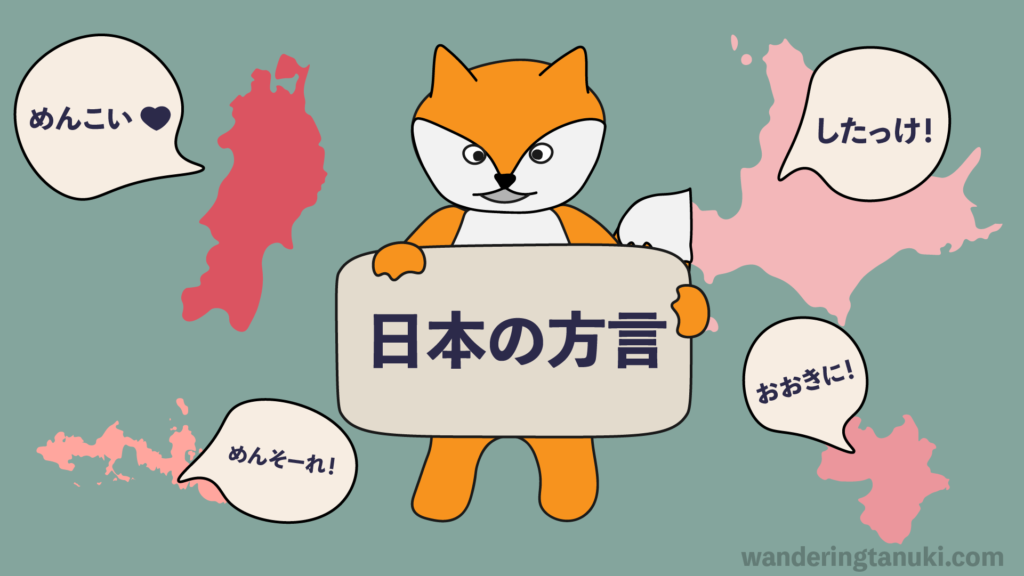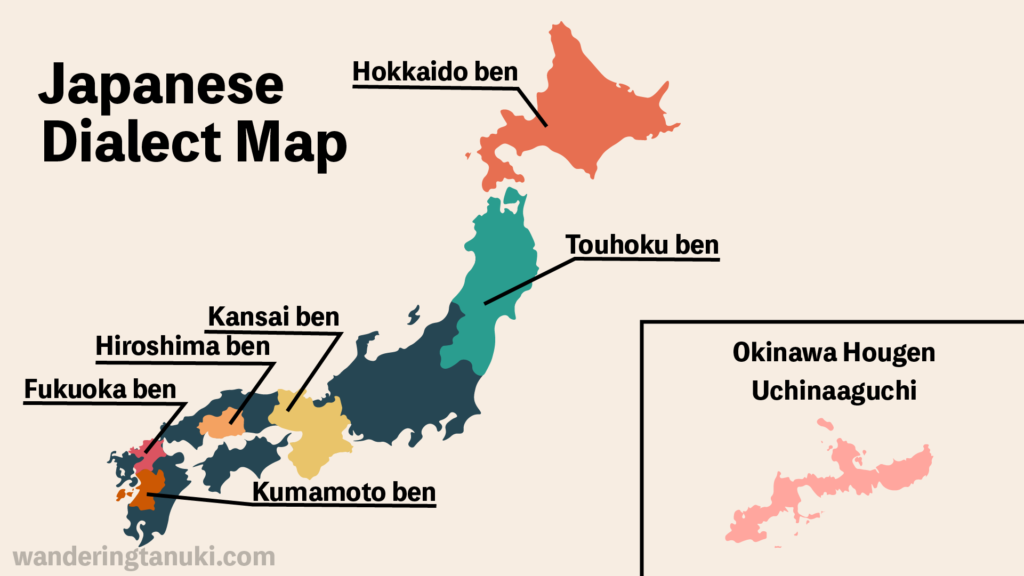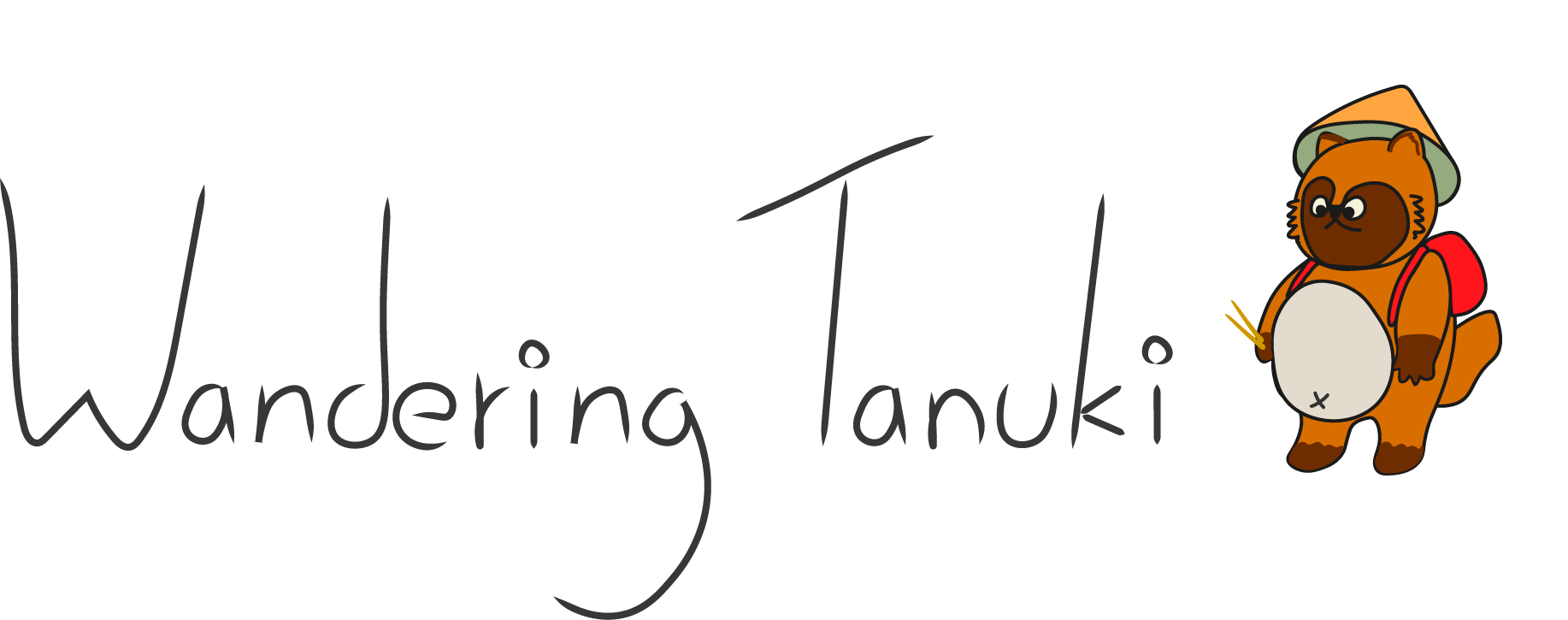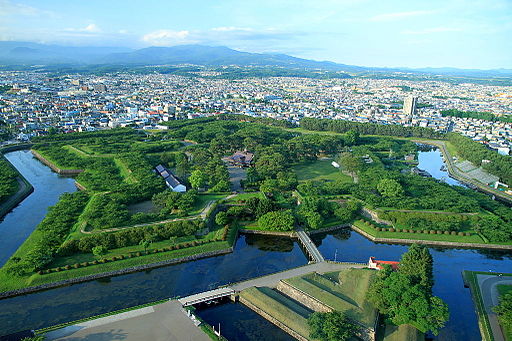Japanese Dialects: Accents from Hokkaido to Okinawa
Did you know that there are different Japanese dialects? As you’re learning Japanese, you might notice that native speakers have different accents and words depending on where they are from. The Japanese that you’re learning is called hyojungo or kyotsuugo, which means common or standard language.

We’ll first go over general information about Japanese dialects, but you’re welcome to skip ahead to the different dialects!
Note: I’m a speaker of standard Japanese, so the audio clips may not be exactly as the dialect sounds. However, I’ve recorded them to the best of my ability. Keep in mind that there are more dialects and many other characteristics/words than I could fit in this article!
An Introduction to Japanese Dialects
How do you say dialect in Japanese?
Dialect is 方言 (hougen) in Japanese and translates to “way of speech”. When referring to specific regional dialects you use 弁(ben). For example, Kansai dialect is 関西弁 (kansai ben).
What is Hyojungo or Kyotsugo?
The Japanese that you encounter in textbooks and Japanese classes is called hyojungo or kyotsugo. During the Meiji restoration of 1868, the language taught in schools and used in official communication was standardized.
Although each region tends to have its own dialects, most people are able to speak and communicate in hyojungo. This “neutral” way of speaking was adopted from Tokyo-style speech. Japanese people consider the accents of Tokyo and surrounding areas to be neutral and without an accent.
The Japanese attitude towards dialects
In the past, those from outside Tokyo would feel shame for their dialects and had to change to hyojungo. In recent times, dialects have been getting more attention and popularity. The unique regional accents are allowing people to feel pride in where they come from. Many people also find these dialects attractive or charming!
In professional situations, there is still an expectation for hyojungo or the native dialect in the area. For example, it can be weird to speak a Kansai dialect in a professional situation in Tokyo. For casual communication, feel free to experiment and have fun with dialects!
General dialect regions:
Japanese dialects have three broad regions: The eastern, western, and kyuushuu (southern) areas. Within each area there can be similar structures and intonations. However, there are also smaller sub-dialects that each have their own unique characteristics and words.
In this article, we’ll be focusing on Hokkaido, Touhoku, Kansai, Hiroshima, Fukuoka, Kumamoto, and Okinawa dialects! Here’s a map so you can get a regional overview:

Hokkaido ben
京浜にけ at Japanese Wikipedia, CC BY-SA 3.0, via Wikimedia Commons
Hokkaido is the northernmost prefecture of Japan. This dialect is relatively new because it is a mixture of many different regional dialects. Around the Meiji period there was an influx of settlers who came from different areas of Japan. There is some debate as to whether Hokkaido ben is an actual dialect or just a mixture of dialects. However, there are clearly special words and phrases that only Hokkaido people use.
Characteristics
Hokkaido ben can be a mixture of dialects from the Touhoku and Hokuriku regions. This is where most of the settlers of present day Hokkaido came from. Over time, they have also developed their own ways of speech. In urban areas like Sapporo, you can expect the speech to be closer to standard Japanese.
Special words and phrases
なまら – namara – very
Many Japanese dialects have their own ways of saying “very” and the Hokkaido dialect is no exception. If you want to add something extra to adjectives, you can add なまら (namara). For example, “very cold” could be なまら寒い (namara samui)
投げる – Nageru – to throw away trash
This word is used in standard Japanese for “to throw”. However, throwing away trash uses the word 捨てる (suteru). In Hokkaido the same word for “throw” is used for the trash.
履く – Haku – to wear pants and gloves
In standard Japanese, 履く(haku) is associated with wearing pants or underwear. In Hokkaido, the same word is used for wearing gloves. This can be surprising for those who are used to standard Japanese.
こわい – Kowai – to be tired
You might be familiar with this word which means “scary” in standard Japanese. In Hokkaido, it can mean something completely different!
したっけ – Shitakke – see you
This is a special goodbye used by people from Hokkaido. It is a casual goodbye for friends and family.
Touhoku ben

田附宏秀, CC BY 3.0, via Wikimedia Commons
The Tohoku region includes the north part of Japan below Hokkaido. It is mountainous, scenic, and popular for tourism. The Touhoku dialect is associated with a country-like image. You’ll sometimes notice that anime characters are voiced with the Touhoku dialect when they are from the countryside.
Characteristics
Some defining characteristics of this dialect are that they don’t differentiate between the sounds like し (shi) and す (su). 寿司 (sushi), 煤 (susu), and 獅子(shishi) are all pronounced the same way. These words would be pronounced しし (shishi) or すす(susu) depending on the region of Touhoku.
They also don’t differentiate the sounds for ち(chi) and つ(tsu), so the word for cheese チーズ (chiizu) would be ツーズ (tsuuzu). Because of this unique pronunciation, Touhoku ben has been nicknamed zuuzuu ben.
Special words and phrases
めんこい – menkoi – cute
This is a special Touhoku word that means “cute”. You can use it to replace the word かわいい (kawaii) in standard Japanese.
めんこ – menko – good child
If you want to praise a child, this is a phrase that Touhoku people might use. It’s a compliment for good children.
あんこ – anko – brain
This is a funny way to say “brain”. In standard Japanese, あんこ (anko) refers to sweet red bean paste.
いずい – izui – itchy
In standard Japanese, かゆい (kayui) is the word for itchy. In the Touhoku region, you might hear this word instead.
あっぺとっぺ – appe toppe – doesn’t make sense or confusing
This is a cute Touhoku word that is used when something makes no sense. Touhoku people like to use ぺ (pe) in their phrase endings.
Kansai ben

C.L. Kao (eddie5150), CC BY-SA 3.0, via Wikimedia Commons
This is one of the most famous Japanese dialects because it makes up a large proportion of Japanese speakers outside of the Kanto region (where Tokyo is located). The Kansai region includes large cities like Kyoto and Osaka. It is like the southern accent of Japan. Japanese people tend to associate Kansai ben with loud, friendly, outgoing, and funny personalities.
Kyoto vs. Osaka slight differences
Although the Kansai dialect includes both Kyoto and Osaka, these two cities can have differences in their dialects. The Kyoto accent is considered classy because of the tradition associated with the city. Kyoto people also tend to speak slower while Osaka people speak louder and faster.
Examples of some differences:
来ない – Konai – To not come
Osaka: けーへん (keehen)
Kyoto: きーへん (kiihen)
無理です – muri desu- it’s not possible
Osaka: あかんねん (akan nen)
Kyoto: あかんし (akanshi)
Characteristics
When you hear the Kansai dialect you’ll notice that the pitch and intonation of words can be different from hyojungo.
For example, the word 橋(hashi) meaning bridge is accentuated as follows:
Kansai dialect: Hashi
Standard Japanese: Hashi
To make things more complicated, the same sounding word for chopsticks 箸 (hashi) is accentuated like this:
Kansai dialect: Hashi
Standard Japanese: Hashi
There are many small differences that you’ll start to notice the more you listen to the Kansai dialect!
Special words and phrases
おおきに – Ookini – Thank you
Although more common in Kyoto, you’ll notice that some people will say this phrase instead of the usual ありがとう (arigatou) for thank you.
なんでやねん – nandeyanen – why?
This phrase became well known with the popularity of Kansai comedians. It is used when saying “why?”. Feel free to try it out next time you want to show some Kansai flare.
カッター – kattaa – dress shirt
In standard Japanese, dress shirt is usually ワイシャツ (waishatsu). In Kansai dialect you’ll find that dry cleaners will post advertisements with カッター (kattaa) meaning dress shirt.
さら – sara – new
When saying “new” in standard Japanese, people will use 新品 (shinpin). The Kansai dialect tends to use さら(sara) when expressing that they got a new item.
ほな – hona – good bye
This is a cool and casual goodbye! It means something like “well then, see ya”.
Hiroshima ben

663highland, CC BY-SA 3.0, via Wikimedia Commons
The Hiroshima dialect is spoken in the Hiroshima prefecture located in the south west part of Japan. Hiroshima has both mountains and sea, and is famous for the seafood and shrines. The Hiroshima dialect was thought to be a bit scary or strong, but it has gained popularity through T.V. and celebrities.
Characteristics
In Hiroshima ben, the accentuation of words can be different from standard Japanese. For example, the word for cloud 雲 (kumo) would be pronounced kumo instead of kumo (in standard Japanese).
One of the main characteristics of Hiroshima dialect are phrase endings and the way that particles are squished together. Some examples are that は (ha) and を(o) are not pronounced clearly. In Hiroshima dialect, 薬を… (kusuri o..) would become くすりょう… (kusuryuu).
Here are some Hiroshima ben phrase endings:
じゃ(ja) instead of だ(da)
Example “it’s rain”:
Standard Japanese 雨だ (ameda) → Hiroshima ben 雨じゃ (ameja)
とる(toru) instead of てる(teru)
Example “it’s raining”:
Standard Japanese 雨が降ってる (ame ga futteru) → Hiroshima ben 雨が降っとる (ame ga futtoru)
じゃろ(jaro) instead of だよね(dayone)
Example “it’s rain, isn’t it?”:
Standard Japanese 雨だよね (amedayone) → Hiroshima ben 雨じゃろ (ame jaro)
Special words and phrases
ぶち – buchi – very
Like every dialect, Hiroshima ben also has its own version of “very”. It can be used to amplify adjectives.
たいぎぃ – taigii – troublesome
This word can be used instead of めんどくさい (mendokusai) and can mean troublesome, annoying, or tiresome.
でべそ – debeso – outgoing
In standard Japanese, でべそ (debeso) normally refers to an outward belly button. However, in the Hiroshima dialect, it also means outgoing people or those who like to go out.
なんしよん? – nanshiyon? – what are you doing?
This is the Hiroshima style way of asking someone what they’re up to. It is equivalent to the standard Japanese 何してるの?(nanishiiteruno?).
いらう – irau – to touch
Instead of using さわる (sawaru) for the verb “to touch”, Hiroshima people might say いらう (irau).
Fukuoka ben / Hakata ben

そらみみ, CC BY-SA 4.0, via Wikimedia Commons
These two Japanese dialects are similar and refers to the dialect spoken in Fukuoka prefecture. Hakata is a ward in Fukuoka city that developed its own dialect. However, these days it makes more sense to group Fukuoka dialect and Hakata dialect together as the dialect of Fukuoka.
Characteristics
Fukuoka is located in Kyushu and their dialect can be somewhat similar to Kumamoto ben. However, a key difference is that Fukuoka ben uses accentuation like standard Japanese. Other characteristics are that command form verbs like 食べろ (tabero – eat), or 着ろ (kiro – wear) will turn into 食べれ (tabere) or 着れ (kire). The ろ (ro) is replaced with れ (re). There are many other changes in the speech from standard Japanese that you’ll find as you listen to a Fukuoka ben speaker.
Special words and phrases
なんち?- Nanchi? – what did you say?
In casual speech, Fukuoka people will ask なんち? (nanchi) when they didn’t hear what you said. It is a cute alternative to the standard Japanese なに? (nani?) or “what?”.
ばり – bari – very
This is “very” in Fukuoka ben. For example, “very cute” would be ばり可愛い (bari kawaii).
なんしおうと?- Nanshiouto? – what are you doing?
If you want to ask what someone’s up to in Fukuoka ben, なんしおうと? (nanshiouto) would work great. In standard Japanese, it would be equivalent of なにしてるの?(nanishiteruno?).
よかよ!- yokayo! – sure!
This is an enthusiastic way to answer someone’s invitation or idea. In standard Japanese, it would be same as いいよ(iiyo).
好きっちゃけど – sukicchakedo – I like you
Japanese people rank Fukuoka ben as one of the cutest Japanese dialects. The Fukuoka ben style “I like you” is considered unique and attractive.
Kumamoto ben

くろふね, CC BY-SA 4.0, via Wikimedia Commons
Kumamoto is located on the island of Kyushu in the southern part of Japan. They boast their own unique dialect and it is home of the Kumamoto castle. People around Japan tend to view the Kumamoto dialect as very cute and special!
Characteristics
This dialect is unique because it has no accent! This means that the pronunciation of the word doesn’t influence the meaning. For example, in standard Japanese you would pronounce 箸 (hashi – chopstick) and 橋 (hashi – bridge) differently based on the meaning. In Kumamoto dialect, the two words are the same. You can only figure out the meaning based on context.
Some other characteristics include replacing い (i) with か(ka) in i-adjectives. 怖い (kowai) or “scary” would be こわか (kowaka). うまい (umai) or “tasty” would be うまか (umaka). There are many other differences and words that you’ll start to notice when listening to Kumamoto speakers.
Special words and phrases
がまだす – Gamadasu – work hard
This is a unique Kumamoto phrase that you can use similarly to 頑張る(ganbaru) in standard Japanese.
だご – dago – very
If something is very delicious or very cute you can use だご in front of the adjective.
とっとっと?- tottotto? – Is this seat available?
This is a funny phrase that you can use to ask if a seat is available. You might hear people say this at concert venues or bars to check if the seat is empty.
なおす – naosu – to put something back
In standard Japanese, なおす(naosu) means to fix something. However, in Kumamoto ben it means putting things away.
ひごもっこす – higomokkosu – a stubborn kyushu person
This word represents the spirit of the Kumamoto people. It usually refers specifically to men who are stubborn and true to their values.
Okinawa hougen / Uchinaaguchi

Paipateroma, CC BY-SA 4.0, via Wikimedia Commons
Okinawa is an island off of Japan that has its own rich history. In the 1600’s, the Japanese conquered the indigenous people of Okinawa. Some people in Okinawa still speak the indigenous language. However, most Okinawans speak a dialect of Japanese influenced by other languages. This is known as Okinawa hougen or Uchinaaguchi.
Characteristics
The Okinawan Japanese dialect has a mixture of indigenous language and loan words from English. The U.S. held power for a brief time in Okinawa after WWII. This is why you will also see some American influence in the culture and food if you visit Okinawa.
On top of the unique Okinawan words, you’ll notice that the pronunciation is very different in Okinawa. They tend not to use the sounds for え (e) and お (o), and changing them to い (i) and う(u) instead. There are many other differences from standard Japanese that you’ll notice if you listen to an Okinawan speaker.
Special words and phrases
めんそーれ – mensoore – welcome
This is a special Okinawan word for “welcome”. You’ll often hear this in restaurants and businesses.
ハイサイ・ハイタイ – haisai・ haitai – hello
In the Okinawan dialect, these two words mean”hello” . Women use “haitai” and men use “haisai”.
ウチナー – uchinaa – okinawa
Okinawa is pronounced “uchinaa” in the native speech style. You’ll see this word often to refer to Okinawa.
ちゅら – chura – beautiful
This is a famous word that means “beautiful”. You’ll hear or see this word for beautiful things and people.
だーる – daaru – uh huh
In casual speech you might hear people say “daaru” in Okinawa. This means something like “uh huh” or when you want to show agreement to what you’re hearing.
Other languages in Japan
It’s briefly worth mentioning that there are other languages in Japan. Instead of dialects, these are distinct languages that are separate from Japanese. The two main indigenous languages are Ryukyuan and Ainu. Both languages are endangered, as less and less people speak them.
Ryukyuan languages refer to the indigenous languages of the Ryukyu islands of Japan like Okinawa and Kagoshima. These languages are in the same family as Japanese, but are separate languages.
The Ainu language is the language of the Ainu people who are indigenous to Hokkaido. This language is unique and doesn’t fall into other language families.
I hope that this article covered everything you need to know about Japanese dialects! As you meet different people, you’ll be able to appreciate the wide range of spoken Japanese. If you’re interested in other Japanese language learning blog content be sure to check out Japan in Japanese: Is it Nippon or Nihon? or Religion in Japan: Shinto and Buddhism
~ Tanuki
Some of the Japanese sources used in this article:
https://men-joy.jp/archives/514879
https://www.hituzi.co.jp/epublish/academic_journal/nhng_onsei/nihongoonsei003_nhg_02baba.pdf
https://ja.wikipedia.org/wiki/博多弁
https://hokkaido-labo.com/area/all/hokkaido-resional-dialects
https://www.hamajima.co.jp/eigo/okinawa-kotoba/






